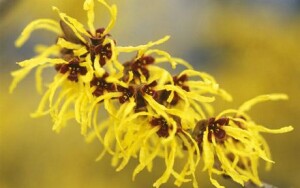As winter days tick down and spring looms ahead, the sap starts to rise in gardeners and trees. A brief snowdrop sighting, a few brave early crocuses, or even a stalk of rhubarb in the market make hearts beat faster. Witch hazel works the same magic.
Our great-grandparents used a bottled witch hazel decoction as an effective astringent. Some of them may also have grown the shrubs in the back yard. Pharmaceutical science has since given us all kinds of manufactured astringents that purport to be better and are certainly more expensive. Horticultural science is hard pressed to find many shrubs that are as welcome at winter’s end as witch hazel.
You have probably run across witch hazel, but may have mistaken it for a strange-looking forsythia. There are four species of Asian or North American witch hazel shrubs or small trees within the genus Hamamelidaceae, which is also home to the statuesque sweet gum tree and the sweetly-scented fothergilla shrub. The tallest witch hazel can grow to 30 feet, but most ornamental varieties are considerably shorter, topping out at anywhere from six to 12 feet, depending on variety. The key identifiers for most of them are the grayish bark and, especially, the fuzzy brown flower buds. In late winter or early spring, those buds open to release herds of yellow, gold or orange spiders, with legs splaying in all directions.
Unlike real arachnids, witch hazel “spiders” do not race away from humans, but prefer to stay around and show off their bright petals. The most popular varieties exude a strong, sweet-spicy fragrance.
A neighbor of mine has a glorious witch hazel, one of the few within a five mile radius of my house. It is probably six feet tall and covered with yellow blooms in March. If I were a betting person, I would say that the variety is probably ‘Arnold Promise’, which is possibly the best known example of the hybrid or intermediate witch hazel that is known to botanists as Hammamelis x intermedia. This happy marriage of Chinese and Japanese species, orchestrated years ago by the Arnold Arboretum in Boston, has resulted in a tough shrub with large, fragrant yellow flowers, accented with reddish-brown central calyx cups. Those flowers last for up to a month, providing visual interest while the rest of the garden revs up in the spring.
‘Arnold Promise’ holds extra promise for the fall, when its shield-shaped dark green leaves are clothed in vivid red-orange. The leaves eventually depart for the winter, but the fall show is worth it.
A few gardeners I know spurn yellow flowers. For them, there is ‘Jelena’, sometimes known as ‘Copper Beauty’, another variety of Hamamelis x intermedia. Blooming in late winter to early spring, ‘Jelena’ sports orange-copper flowers, generally with four petals apiece. As fragrant as ‘Arnold Promise’, with a height and spread of eight to 12 feet, ‘Jelena’ is a beautiful landscape shrub. Woody plant guru Michael Dirr notes that orange-flowered witch hazels often sport even more dramatic fall color than their yellow-flowered relations. This is something to consider if you are choosing a stand-alone specimen plant.
The number of commercially available hybrid witch hazels has increased over the years. German breeders, in particular, seem fascinated by the Hamamelis genus. In addition to ‘Arnold Promise’, you can buy the slightly more compact ‘Angely’ and the larger ‘Primavera’, both with yellow-shaded blooms. ‘Aphrodite’ bears orange flowers and grows slightly larger than ‘Jelena’. A number of intermediate varieties feature red “spiders’, including the large, ‘Carmine Red’, the somewhat smaller ‘Diane’, or the relatively compact ‘Firecracker’.
Considering their generally unfussy nature, hybrid witch hazels and witch hazels in general, should be more widely grown. If you have a sunny or very lightly shaded situation, with rich, well-drained soil, the average Hamamelis will be very happy. Amend clay soil and keep the witch hazel comfortably moist during drought periods. The one thing you will not have to apply to witch hazel shrubs is deer repellent, as deer tend to reject them.
If you have the room, witch hazels make excellent hedges and are also suitable for sunny slopes in need of erosion control. Watch for and remove root suckers at the bases of established plants. Many witch hazels are grafted, with a less hardy variety surgically attached to a hardier, native rootstock. Failure to remove the root suckers will most likely mean that the less showy native “witch” will eventually outcompete the weaker, but showier variety that you chose.
Most good nurseries carry ‘Arnold Promise’ and possibly a few other varieties. For a somewhat larger selection, go to ForestFarm, 14643 Watergap Rd, Williams, OR 97544; (541) 846-7269; www.forestfarm.com. Print catalog available.

